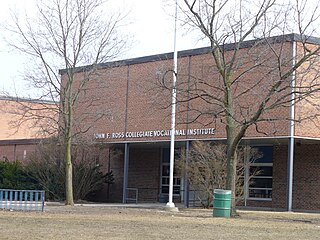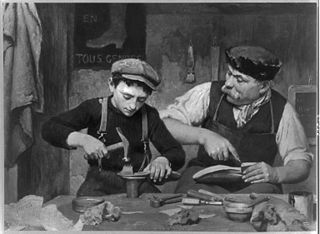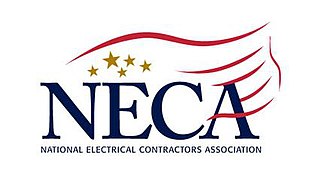
Vocational education is education that prepares people for a skilled craft as an artisan, trade as a tradesperson, or work as a technician. Vocational education can also be seen as that type of education given to an individual to prepare that individual to be gainfully employed or self employed with requisite skill. Vocational education is known by a variety of names, depending on the country concerned, including career and technical education, or acronyms such as TVET and TAFE.

Apprenticeship is a system for training a new generation of practitioners of a trade or profession with on-the-job training and often some accompanying study. Apprenticeships can also enable practitioners to gain a license to practice in a regulated occupation. Most of their training is done while working for an employer who helps the apprentices learn their trade or profession, in exchange for their continued labor for an agreed period after they have achieved measurable competencies.

Carpentry is a skilled trade and a craft in which the primary work performed is the cutting, shaping and installation of building materials during the construction of buildings, ships, timber bridges, concrete formwork, etc. Carpenters traditionally worked with natural wood and did rougher work such as framing, but today many other materials are also used and sometimes the finer trades of cabinetmaking and furniture building are considered carpentry. In the United States, 98.5% of carpenters are male, and it was the fourth most male-dominated occupation in the country in 1999. In 2006 in the United States, there were about 1.5 million carpentry positions. Carpenters are usually the first tradesmen on a job and the last to leave. Carpenters normally framed post-and-beam buildings until the end of the 19th century; now this old-fashioned carpentry is called timber framing. Carpenters learn this trade by being employed through an apprenticeship training—normally four years—and qualify by successfully completing that country's competence test in places such as the United Kingdom, the United States, Canada, Switzerland, Australia and South Africa. It is also common that the skill can be learned by gaining work experience other than a formal training program, which may be the case in many places.

An electrician is a tradesperson specializing in electrical wiring of buildings, transmission lines, stationary machines, and related equipment. Electricians may be employed in the installation of new electrical components or the maintenance and repair of existing electrical infrastructure. Electricians may also specialize in wiring ships, airplanes, and other mobile platforms, as well as data and cable lines.
The International Brotherhood of Electrical Workers (IBEW) is a labor union that represents approximately 820,000 workers and retirees in the electrical industry in the United States, Canada, Guam, Panama, Puerto Rico, and the US Virgin Islands; in particular electricians, or inside wiremen, in the construction industry and lineworkers and other employees of public utilities. The union also represents some workers in the computer, telecommunications, and broadcasting industries, and other fields related to electrical work.
A film school is an educational institution dedicated to teaching aspects of filmmaking, including such subjects as film production, film theory, digital media production, and screenwriting. Film history courses and hands-on technical training are usually incorporated into most film school curricula. Technical training may include instruction in the use and operation of cameras, lighting equipment, film or video editing equipment and software, and other relevant equipment. Film schools may also include courses and training in such subjects as television production, broadcasting, audio engineering, and animation.

A lineworker constructs and maintains the electric transmission and distribution facilities that deliver electrical energy to industrial, commercial, and residential establishments. A lineworker installs, services, and emergency repairs electrical lines in the case of lightning, wind, ice storm, or ground disruptions. Whereas those who install and maintain electrical wiring inside buildings are electricians, lineworkers generally work at outdoor installations.
Cognitive apprenticeship is a theory that emphasizes the importance of the process in which a master of a skill teaches that skill to an apprentice.
A dual education system combines apprenticeships in a company and vocational education at a vocational school in one course. This system is practiced in several countries, notably Germany, Austria, Switzerland, South Tyrol and in the German-speaking Community of Belgium, but also for some years now in South Korea.
Edwin D. "Ed" Hill was an electrical worker, labor union activist and labor leader in the United States. He was the president of the International Brotherhood of Electrical Workers (IBEW), AFL-CIO from 2001 until his retirement in 2015.
The apprentice perspective is an educational theory of apprenticeship concerning the process of learning through active participation in the practices of the desired skills, such as during workplace training. By working with other practitioners, an apprentice can learn the duties and skills associated with the position without formal teaching. In the process of training, apprentices also have the chance to specialize; as they are supervised, their specific talents and contributions within the field are taken into account and integrated into the overall practice.
An electrical contractor is a business person or firm that performs specialized construction work related to the design, installation, and maintenance of electrical systems. An electrical contractor is different from an electrician; an electrician is an individual tradesman and an electrical contractor is a business person or company that employs electricians. Both usually hold licenses and insurances to properly and safely operate a business, protecting the employees and home owners/business owners from insurance liabilities. These requirements vary from state to state. Electricians may work for an electrical contractor, or directly for individuals or companies.

The National Electrical Contractors Association (NECA) is a trade association in the United States representing the electrical contracting industry through advocacy, education, research, and standards development.
Registered Apprenticeship is a program of the United States Department of Labor that connects job seekers looking to learn new skills with employers looking for qualified workers. Employers, employer associations, and joint labor-management organizations, known collectively as "sponsors", provide apprentices with paid on-the-job learning and academic instruction that reflects industry needs. The goal of such instruction is to provide workers with advanced skillsets that meet the specific needs of their employers.

The Building and Construction Trades Department, commonly known as North America's Building Trades Unions (NABTU), is a trade department of the American Federation of Labor and Congress of Industrial Organizations (AFL–CIO) with 14 affiliated labor unions in the building trades. It was originally founded by the American Federation of Labor in 1907.
Apprenticeships have a long tradition in the United Kingdom, dating back to around the 12th century. They flourished in the 14th century and were expanded during the industrial revolution. In modern times, apprenticeships were formalised in 1964 by act of parliament and they continue to be in widespread use to this day.
Apprenticeship programs in the United States are regulated by the Smith–Hughes Act (1917), The National Industrial Recovery Act (1933), and National Apprenticeship Act, also known as the "Fitzgerald Act."

Megan Cornish is an American socialist feminist and labor activist with the Freedom Socialist Party (FSP) and Radical Women, as well as a retired electrician with Seattle City Light. Cornish became an electrician after participating in an affirmative action program in 1974. Much of her activism work has focused on fighting workplace discrimination at Seattle City Light.
Kenneth W. Cooper is an American labor union leader.
Lonnie R. Stephenson is a former American labor union leader.







